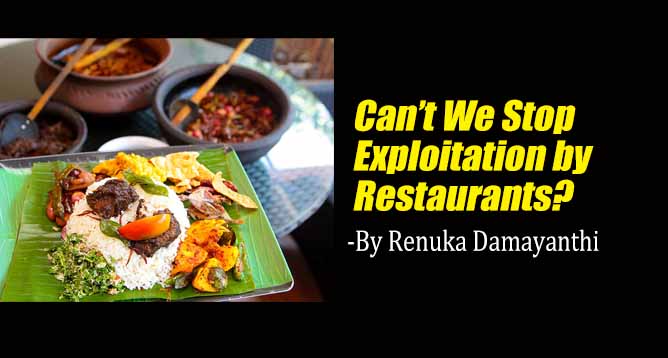-By Renuka Damayanthi

(Lanka-e-News -16.Oct.2024, 8.55 pm) A state intelligence officer was reportedly hospitalized after being assaulted by a group of hotel employees in Kotmale. The incident occurred when the officer inquired about a charge of Rs. 50 for a simple snack. The officer, who was traveling from Colombo to attend a training program in Nuwara Eliya, had stopped at a hotel for tea along with other passengers. He requested a snack but was shocked to be asked for Rs. 50. When he questioned the fairness of the price, an argument ensued, leading to an assault by the hotel staff. Following this, the officer lodged a complaint with the police and was admitted to Nuwara Eliya Hospital. It is reported that one of the hotel employees also filed a complaint, claiming he was assaulted.
A recent personal experience reminds me of another incident. A couple I know went to a nearby town and stopped at a lakeside restaurant for lunch. They ordered rice and fish, but when the bill came, they were shocked to see it amounted to Rs. 1,900. Thinking it was a mistake, they asked the waiter for clarification. The response was that the price of each fried fish fillet was Rs. 500. Despite the menu listing a lower price, they were told the higher price was for “fresh lake fish.” Unable to argue further, they paid the bill and left, feeling exploited.
Unfortunately, this kind of exploitation is not uncommon. While high-end restaurants and five-star hotels display clear price menus, giving customers peace of mind, ordinary eateries often fail to do so. In many small restaurants, prices are hidden or unlisted, leaving customers vulnerable to unexpected charges. This practice seems designed to deceive the average consumer.
According to Sri Lankan law, all food items sold must display their prices. The Consumer Affairs Authority Act, passed in January 2003, empowers the Consumer Affairs Authority (CAA) to protect consumers and regulate unfair business practices. Despite the legal provisions, enforcement remains weak, and exploitation continues unchecked.
At many eateries, prices are not displayed on menus or boards, and printed bills are not provided. Even worse, customers often receive a tiny, non-itemized receipt that makes it impossible to verify what they are paying for. Restaurants could easily offer printed bills or use electronic systems, but many choose not to.
The cost of a basic meal, such as “rice and curry,” can vary significantly depending on ingredients, with prices ranging from Rs. 250 to Rs. 500 or more. Establishing a standardized price is difficult, given the diversity of food preparation methods. Still, it’s reasonable to expect a simple meal to cost around Rs. 200 to Rs. 250. Yet, many small restaurants charge significantly more without justification.
Consumers have the right to know the prices of the food they consume. The government must ensure that eateries display clear price lists and issue proper bills to prevent exploitation. While complaints can be made to the Consumer Affairs Authority via the hotline or through formal channels, the likelihood of effective action is low. Urgent reforms are needed to protect the public from unfair pricing practices in restaurants.
---------------------------
by (2024-10-16 15:22:15)
Leave a Reply